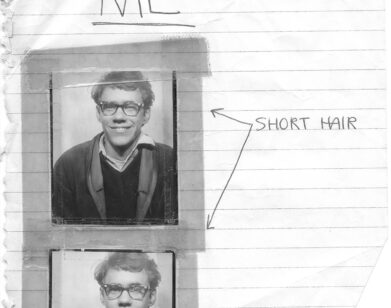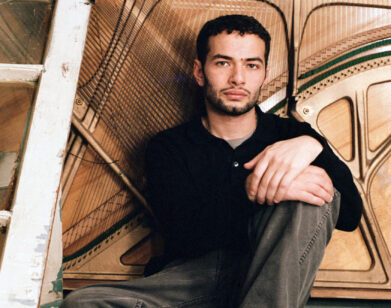Birth of the Internet
JONAS MEKAS IN VENICE, ITALY, MAY 2015. PORTRAIT BY CARL J ASQUINI. SPECIAL THANKS: KODAK ALARIS.
From Salvado Dalí and John Lennon to Britney Spears circa 2007, pioneering avant-garde filmmaker Jonas Mekas has seen and recorded it all. Born in Lithuania in 1922, the artist fled because of the war in 1944, but was imprisoned in a labor camp for eight months and then studied at University of Mainz for two years, before immigrating to America in 1949. Now, at the age of 93, Mekas is showcasing a survey of digital works throughout the city of Venice—from the only Burger King in town to an underground video art space.
Titled “The Internet Saga” and presented by Francesco Urbano Ragazzi in collaboration with Zuecca Project Space, the solo exhibition consistently returns to Mekas’ online endeavors, even though many of the films are analog. Mekas, who became the founder of New American Cinema and opened New York’s Film Anthology Archives in the early 1960s, has adapted his techiniques alongside technology’s rapid progression and began uploading daily diaries to his website in 2007 (the year after YouTube was invented). The diaries include recently recorded footage as well as archival, previously unseen films. At the Burger King—also known as Palazzo Foscari Contarini, formerly a 16th-century noble residence overlooking the Grand Canal—Mekas’ films take over three windows, which usually play something along the lines of MTV. At Spazio Ridotto, located down a small set of stairs, near San Marco, Mekas shows Birth of a Nation, his 1997, 85-minute long film that depicts 170 filmmakers, friends, and activists who helped form what he calls “the nation of independent filmmakers.”
“Patti Smith, Andy Warhol, Kenneth Anger, LaMonte Young, Allen Ginsberg… they’re all people who contributed to the nation of independent filmmakers. It’s a family,” Mekas says. “Each one did something that nobody else did. Every one of them contributed something special.”
Last week, in honor of the opening of “The Internet Saga,” Mekas hosted “Sleepless Night,” an all-night event in which he screened his films for nine consecutive hours. After welcoming guests, we spoke with the filmmaker, and at 11pm, he was as lively as ever.
EMILY MCDERMOTT: Let’s first talk about this family of independent filmmakers.
JONAS MEKAS: It’s more than a family. It’s international. There was a Hollywood royalty, but then the independent nation of the independent filmmakers. Now we can talk about the birth of the internet nation, the creation of another nation, where anybody can make movies. Any of us, we have one or two cameras in our pockets. This film, [Birth of a Nation], begins in 1952 through 2000. You see little mini portraits of people, mini glimpses of things. Many of them are the only footage of these moments. Filmmakers like to film what’s around them, but sometimes they don’t film themselves.
Independent filmmakers often do not know why they are filming and when they will be filming, but there is always a very strong reason. You have to do it. No choice. Independent filmmakers use the camera to record reality in a way and a style, interested in a certain aspect, which we describe as realism. That’s the art of cinema, because cinema is a huge tree with many, many different branches, from one extreme to another.
MCDERMOTT: The internet obviously wasn’t even conceived when you began making films, so when you could, what made you want to upload videos to the internet? Not everyone does that.
MEKAS: It’s very normal to use the contemporary technologies and systems to disseminate your work. It’s so easy, so simple, so direct. So when I became aware of it, that it exists, why would I not use it?
MCDERMOTT: How do you feel the internet changed your work or your approach to making films?
MEKAS: Every tool of recording or disseminating images affects the content of what you put on it, so of course it affected me. When the video technology developed, then I jumped into the internet and computers. It was natural, normal development and the content changed all the time. It became more and more private and personal.
MCDERMOTT: How did that feel for you, sharing more private and personal experiences?
MEKAS: It’s never too private! It’s a little bit like when you’re writing and sending a letter, only that letters are more private to a person. Here the audience could be very wide. Some people want to be very personal. I do not want that. There are some parts of my life that I keep private, that I do not expose at all. So what I put on website is usually not that private, but I feel the need to exchange. That’s part of our life together, as humanity, as friends.
MCDERMOTT: In terms of the two different spaces where your works are being shown, one is a 16th-century palazzo that’s now a Burger King and this is an underground space.
MEKAS: This Burger King thing, there are several different components. There are 768 pieces and three screens. One is a perpetual, 365-day project I did in 2007. I did one film everyday and I put it on my website. The second screen is what I’m putting on the internet now. The third screen is miscellaneous.
MCDERMOTT: How do you think they speak to each other?
MEKAS: They’re different areas, different periods. It’s all my life, still my life. It’s united by my me—my life and my friends and the world in which I live.
“THE INTERNET SAGA” IS ON VIEW AT PALAZZO FOSCARI CONTARINI AND SPAZIO RIDOTTO THROUGH JUNE 30.
For more from the 56th Venice Biennale, click here.







